What a beautifully concise way of expressing the distinction.
Take this abstract expressionist piece from the Guggenheim Museum's collection, for instance....
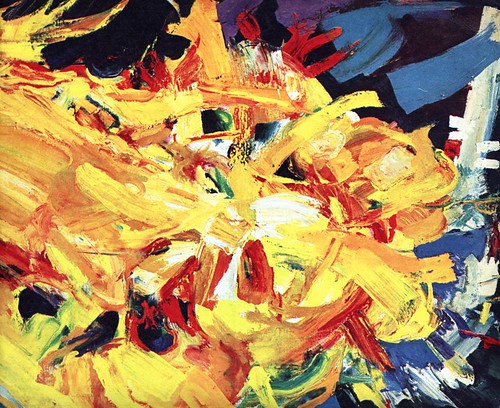
No, I'm kidding - this is actually part of an illustration by long-time Cooper studio illustrator, Bernard D'Andrea, who painted it for Boys' Life magazine in 1965. D'Andrea used the ideas of the painter while still communicating with the readers of the accompanying story (see below).
During the first decade of his career D'Andrea was painting story and advertising illustrations for all the major magazines in that classic Cooper studio style... what author Steven Heller, in an article called "The End of Illustration?" derisively describes as "neo-Rockwellian mannerism... often stiff, puerile, and sanitized."
I wonder if that's how Bernard D'Andrea felt while painting the idealized realism that typified the popular 50's look? Was he itching to release his inner fine artist in a blazing splash of wild Jackson Pollock - inspired action painting?

Neil Shapiro wrote the seminal article on the Charles E. Cooper studio for Illustration magazine #16. He describes the influence of Murray Tinkleman (below) on his fellow illustrators. One of the artists who was there at that time, Don Crowley, is quoted as saying, "I kind of credit Murray with ruining the Cooper Studio, because he got those guys dissatisfied with what they were doing... they just weren't happy doing illustrations any more. They all wanted to be fine artists."
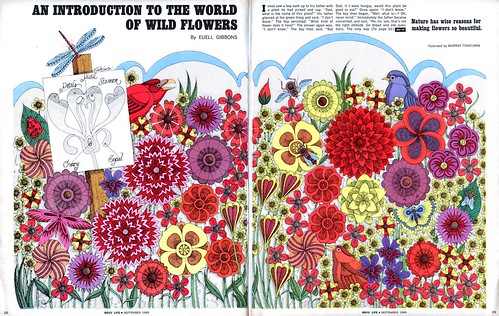
Is that what's really at the heart of the Avant-garde movement in illustration? The desire to be a fine artist? Consider this other quote from Robert Weaver:
"Until the illustrator enjoys complete independence from outside pressure and direction, complete responsibility for his own work, and complete freedom to do whatever he deems fit - all necessaries in the making of art - then illustration cannot be art but only a branch of advertising."
That would be a perfect world, wouldn't it? A major magazine or advertiser pays you a lot of money to paint with total abandon, without restriction or direction or any requirement to collaborate with the other graphic arts professionals involved in the project.
But with that as your central tenet, do you actually qualify for the title of 'illustrator'? It hardly seems realistic to me.
"Illustration is less of an art than a profession in our time," said Weaver. I have to agree... but I agree without the note of regret I read in Weaver's remark.
Here's another quote:
"One of the problems in illustrating for advertising is not the illustrator's problem at all, but the system. When an account comes into the agency all concerned gather and confer. Then they separate and ruminate, and again gather and confer. Visual evidence appears, is hashed over and is finally submitted to the client, is brought back and modified in further conference. When the client seems satisfied, the ads are ready for production, and at this time the agency is forced to call in a complete outsider - the artist. He comes in cold, unaware of all that has gone before and views the accepted layouts all buttoned up tight. What should have been his peculiar province - the excercise of his creative imagination - has largely been done for him and it is no wonder that he is soon concious of operating simply as a technician."
Are these the words of Robert Weaver or one of the other young turks of the Avant-garde movement?
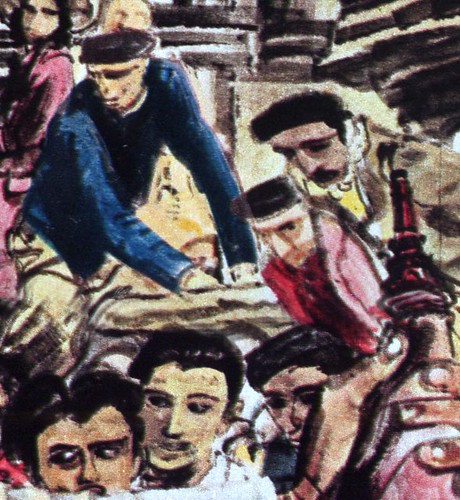
No, they were written by Robert Fawcett in his introduction to Illustrators '59. But you can see that Fawcett was very much in sympathy with the Avant-gardeists. To a greater or lesser degree, I think all of us who are illustrators share this sentiment.
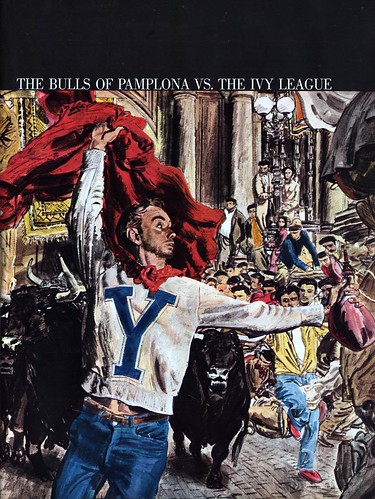
It would be lovely to just draw or paint whatever your heart desires, rebelling against the commercial constraints and compromise that shackle the professional illustrator's natural creativity, that sometimes demand more of a technician than an artist... and have instead the freedom today's youthful counterculture enjoys when they produce hiphop-inspired graffiti art like the piece below.
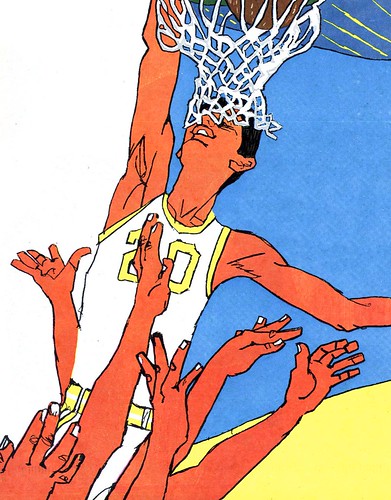
No, again I'm kidding. This is actually a piece by Al Parker from 40 years ago.
But I hope that you are, like me, astonished at Parker's amazing capacity for innovative and creative exploration, for his ability to anticipate and even initiate style and trend far in advance of his peers.
It was wondered aload earlier this week if Parker or Weaver had had a more pronounced impact on illustration as we know it today. If we have to assign responsibility to one single artist for having been the greatest innovator... for, as the commentor put it, moving illustration the greatest distance from where he found it, then I would have to throw my hat in Al Parker's ring.
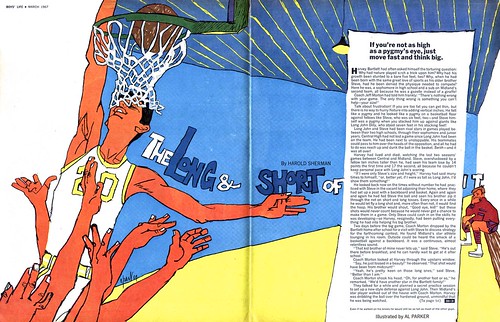
Al Parker was also frustrated by the limitations put on his personal creativity. "An exceptionally innovating performance from the brush... depended to a great extent on the capacity of the art director to evoke it," he once said. "Once evoked, the art director expounded its merits to the magazine, which usually demanded a watered down version."
But in spite of those challenging circumstances, Parker also said, "The illustrator is always subservient to representation. Revolt is limited mostly to its guise, not its premise."
That is to say, you can be as rebellious as you please, just make sure they don't realize it!

The most successful illustrators, like Bob Peak (above and below), have always understood and accepted this reality. Because unlike fine art, illustration is part of a larger collaborative process; so when you are given the opportunity, push the boundaries.
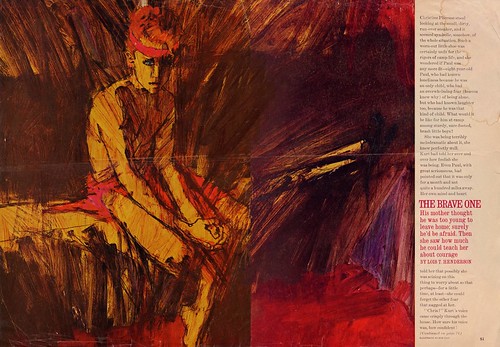
And when they ask for the technician, make sure they pay you well.
As another person commented this week: "Untried territory is fine, but will it put food on the table?"
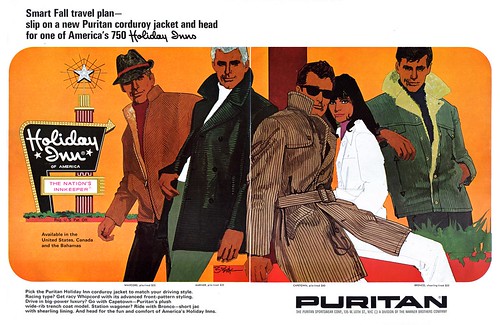
D.B. Dowd, who authored "Abstraction in (Dis)guise" for the Rockwell Museum's Al Parker catalogue gets the last word: Revolt is still an option -- as long as its cloaked.
*My thanks to Tom Watson for providing the Robert Weaver interview, "The Future of Illustration" and the Robert Fawcett introduction from Illustrators '59.
Thanks, Leif, for a rich, thoughtful analysis... well worth waiting an extra day or two for. I agree with you 100% about Parker's contribution-- he wasn't nearly as noisy as Weaver but working within the system, his revolution had a far broader impact.
ReplyDeleteI do like Weaver's work a lot, but your quotes from him make me less sympathetic to his cause. Let's agree, for the sake of argument, that the key distinction between art and illustration is that illustration communicate. But keep in mind that art and illustration BOTH attempted to communicate for about 99% of recorded history. Only in the 20th century when Weaver was painting did fine art start down the path of "art for art's sake," eschewing any communicative or practical or commercial role. Artists before that time would not recognize the role of fine art described by Weaver.
Is this a permanent schism between art and illustration or merely a temporary deviation? In the long history of art, a century hardly counts as a blip on a radar screen. Yet, Weaver-- from his limited perspective-- seems convinced he is talking about timeless truths.
I think the jury is still out on whether fine art chose the superior path. I admit the initial results were quite showy. Weaver was working at a time when abstract expressionism had just taken over the world, and you can understand why it was hard for illustrators to resist its allure. But recently this path has taken fine art to an anemic and often decadent place. In hindsight, it hardly seems to justify the arrogance and bravado that we get from fine artists (and would be fine artists such as Weaver). Things could change again in another century, but right now it's hard to be impressed with the stigma that Weaver attributes to mere "communication."
Good discussion, and it is not suprising that many illustrators would buy the argument that their work was "lesser" than the fine artists, or the avante garde. It's a common enough view. However,the popularity of your blog demonstrates that there may be more "inspiration" in old advertising art because of the creative composition, color, boldness and style than in some alcohol-induced paint splattering done only "because that's how I feel." There is an obvious craft in illustration that is typically missing in the "fine arts." And there is a reason for the old expression among the plebian class, when viewing modern art that goes: "My two-year old could do that!" If nothing else, its a clue that something is amiss. It's a shame that that the dichotomy exists, but I doubt it will ever disappear, as it is based on the seeming distinction between art being done for "crass commercial" reasons and art being done for more "noble" reasons of art for art's sake. However, anyone picking up ART Today will notice where the true con lies -- and its not in a Pepsi ad showing smiling people.
ReplyDeleteDavid;
ReplyDeleteI too am not terribly sympathetic to Weaver's cause - we don't need to agree just for the sake of argument - we can simply agree.
In my opinion art and illustration were essentially the same thing until the 20th century, when the rift began and fine art became something rarified and precious and illustration was relegated to some lower status by the elites because it serves the utilitarian function of communicating with the masses.
Personally, when I read a statement like Marshall Arisman's that Robert Weaver was "the only pictorial genius I have ever met" I have to roll my eyes. Please.
If I can credit the Avant-gardes with one thing it would be that they showed the illustration community at large that they should dare anything and fear nothing.
The nature of the illustration business is a sliding scale with complete creative freedom at one end and slavish techical craft at the other - and we all have to make our peace with the spot we choose for ourselves somewhere along that scale.
Thanks for a fresh and thoughtful presentation, Leif.
ReplyDeleteIt's ironic that modernism is founded on a disdain for public taste, while magazine circulation ultimately depends on it. But the wider public's embrace of modernism was never as hearty as the tastemakers--avante garde illustrators included--may have hoped.
The Saturday Evening Post, to name one magazine, went from a circulation of 13 million in the 50s to a sad demise in 1969. Part of the threat was from the competition from television, but part of it was from the public's growing indifference to the parade of self-indulgent stylistic gimmicks. The areas of illustration that survived TV's onslaught were things like paperback book covers, where modernism never got much of a foothold, and where mostly enlightened art directors gave their illustrators plenty of freedom.
Well Leif, I pretty much knew what my comments were going to be, and then I read your comments above. You have said it for me, better than I would have expressed it. So, I can only add that when I was in art school, the fine arts majors would accuse the illustration majors of being a bunch of prostitutes. This was in the late 50's, and abstraction was coming on strong and touted as being an earthshaking revolutionary movement that would leave literal traditional art in its dust. Well, the dust has settled, and literal traditional art is well, thriving and communicates to the majority of the public... I can't say the same for abstract or Avant-garde' art.
ReplyDeleteDuring the early 1900's until about 1930, fine art and editorial illustrations were heavily influenced by the French impressionists.. using thick painterly brushstrokes and often exaggerated color. It has always personally inspired and influenced my thinking about how I perceived my approach to illustration and fine art.
I think quality illustrators have always been influenced, to one degree or another, by fine art. Also, both illustration and fine art will always be divided into different camps... from literal realism to totally subjective interpretation. And, I suspect we will be having similar speculations and discussions 20 years from now.
I confess, I was a so called "prostitute" for 40 years, because I dared make a living as a "hired wrist", and sometimes even my brain was allowed to weigh in on an assignment. Pushing the envelope didn't interest me... putting food on the table did.
I totally agree with Leif, that Parker was really the trail blazer for all the rest of the Avant-garde' movement illustrators, including Weaver. And, Parker seemed more comfortable in his role as an artist, whose job was to communicate through his drawings and paintings... knowing it wasn't a solo profession.
Tom Watson
Anonymous #1, can I have permission to quote you again & again?
ReplyDeleteVery refreshing words.
A wonderful and insightful post . Parker was definitely a pioneer.
ReplyDeletethis was an interesting read... a further and refreshing expansion of a discussion of some time ago on flickr.
ReplyDeletei have not much to add, but two things that i tend to believe.
one, that constraints as commisions, as it was before the XX century, albeit sometime frustrating allowed art and artists (i mean each of them) to grow in their means of expression, whereas an art free from utilitarian scope, wanders sometime aimlessly.
two, establishing a rift was instrumental to art dealers to levitate the prices of art, at least to make the people perceive that as better than commercial art, so that even the artists end to believe that.
bottom line, there are so many artists and illustrators that the a defining line is very blurred to me, while it comes easier to define the most reknown, as they stand out as well defined per se, per their particular work.
From anonymous #1:
ReplyDeleteOK to quote.